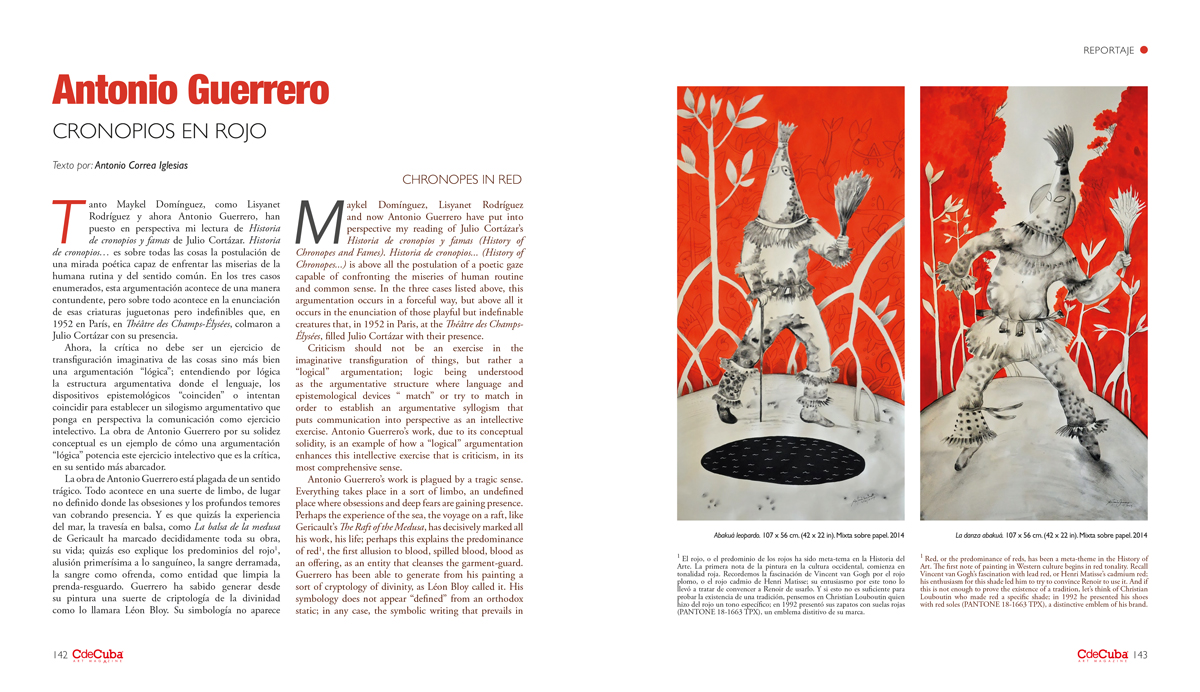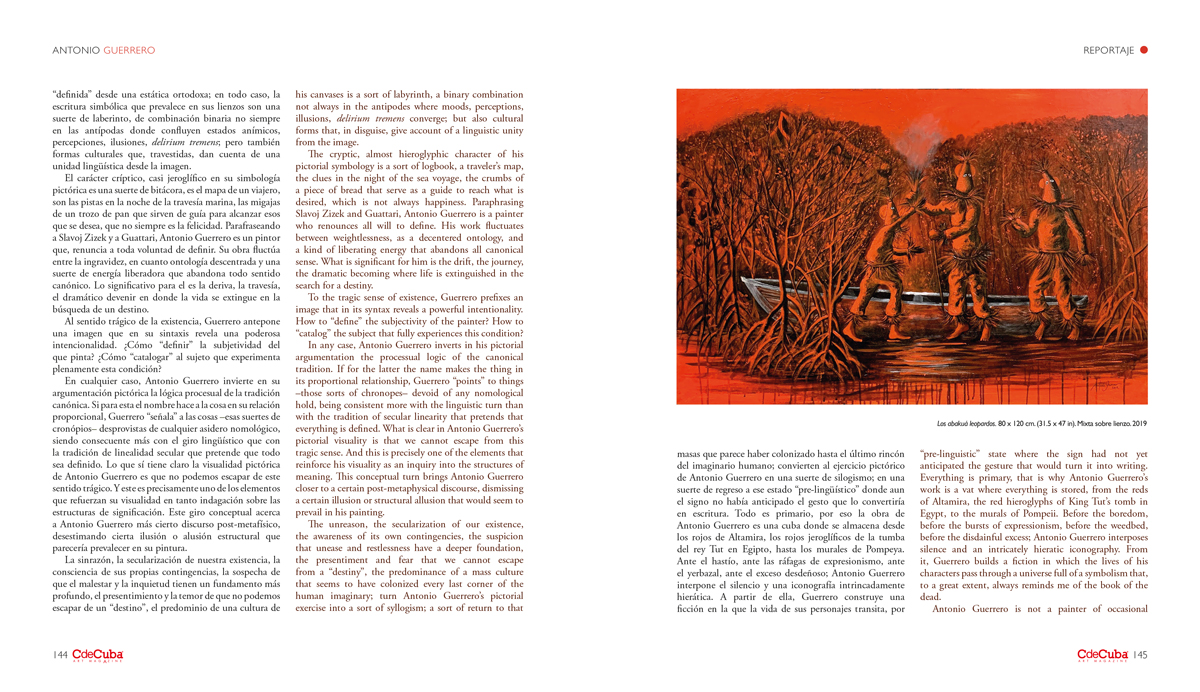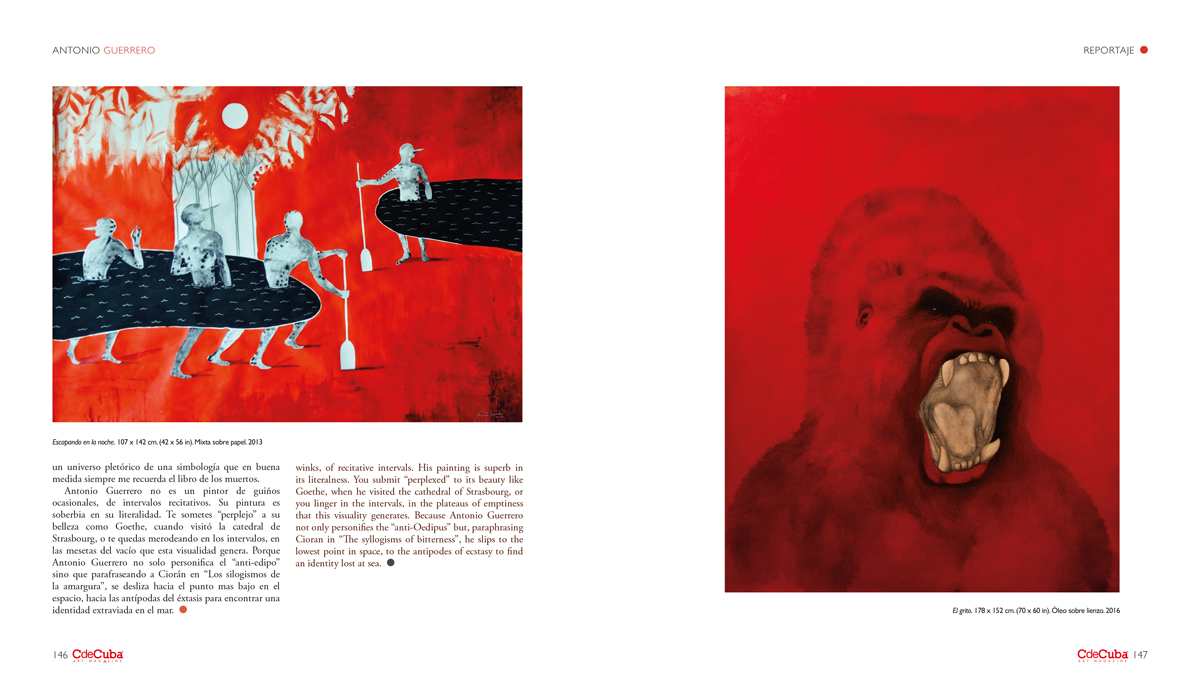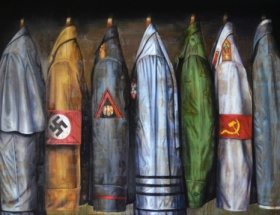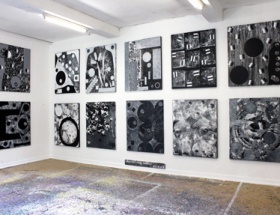Chronopes in Red
By Antonio Correa Iglesias
Maykel Domínguez, Lisyanet Rodríguez and now Antonio Guerrero have put into perspective my reading of Julio Cortázar’s Historia de cronopios y famas (History of Chronopes and Fames). Historia de cronopios… (History of Chronopes…) is above all the postulation of a poetic gaze capable of confronting the miseries of human routine and common sense. In the three cases listed above, this argumentation occurs in a forceful way, but above all it occurs in the enunciation of those playful but indefinable creatures that, in 1952 in Paris, at the Théâtre des Champs-Élysées, filled Julio Cortázar with their presence.
Criticism should not be an exercise in the imaginative transfiguration of things, but rather a “logical” argumentation; logic being understood as the argumentative structure where language and epistemological devices “ match” or try to match in order to establish an argumentative syllogism that puts communication into perspective as an intellective exercise. Antonio Guerrero’s work, due to its conceptual solidity, is an example of how a “logical” argumentation enhances this intellective exercise that is criticism, in its most comprehensive sense.
Antonio Guerrero’s work is plagued by a tragic sense. Everything takes place in a sort of limbo, an undefined place where obsessions and deep fears are gaining presence. Perhaps the experience of the sea, the voyage on a raft, like Gericault’s The Raft of the Medusa, has decisively marked all his work, his life; perhaps this explains the predominance of red1, the first allusion to blood, spilled blood, blood as an offering, as an entity that cleanses the garment-guard. Guerrero has been able to generate from his painting a sort of cryptology of divinity, as Léon Bloy called it. His symbology does not appear “defined” from an orthodox static; in any case, the symbolic writing that prevails in his canvases is a sort of labyrinth, a binary combination not always in the antipodes where moods, perceptions, illusions, delirium tremens converge; but also cultural forms that, in disguise, give account of a linguistic unity from the image.
The cryptic, almost hieroglyphic character of his pictorial symbology is a sort of logbook, a traveler’s map, the clues in the night of the sea voyage, the crumbs of a piece of bread that serve as a guide to reach what is desired, which is not always happiness. Paraphrasing Slavoj Zizek and Guattari, Antonio Guerrero is a painter who renounces all will to define. His work fluctuates between weightlessness, as a decentered ontology, and a kind of liberating energy that abandons all canonical sense. What is significant for him is the drift, the journey, the dramatic becoming where life is extinguished in the search for a destiny.
To the tragic sense of existence, Guerrero prefixes an image that in its syntax reveals a powerful intentionality. How to “define” the subjectivity of the painter? How to “catalog” the subject that fully experiences this condition?
In any case, Antonio Guerrero inverts in his pictorial argumentation the processual logic of the canonical tradition. If for the latter the name makes the thing in its proportional relationship, Guerrero “points” to things –those sorts of chronopes– devoid of any nomological hold, being consistent more with the linguistic turn than with the tradition of secular linearity that pretends that everything is defined. What is clear in Antonio Guerrero’s pictorial visuality is that we cannot escape from this tragic sense. And this is precisely one of the elements that reinforce his visuality as an inquiry into the structures of meaning. This conceptual turn brings Antonio Guerrero closer to a certain post-metaphysical discourse, dismissing a certain illusion or structural allusion that would seem to prevail in his painting.
The unreason, the secularization of our existence, the awareness of its own contingencies, the suspicion that unease and restlessness have a deeper foundation, the presentiment and fear that we cannot escape from a “destiny”, the predominance of a mass culture that seems to have colonized every last corner of the human imaginary; turn Antonio Guerrero’s pictorial exercise into a sort of syllogism; a sort of return to that “pre-linguistic” state where the sign had not yet anticipated the gesture that would turn it into writing. Everything is primary, that is why Antonio Guerrero’s work is a vat where everything is stored, from the reds of Altamira, the red hieroglyphs of King Tut’s tomb in Egypt, to the murals of Pompeii. Before the boredom, before the bursts of expressionism, before the weedbed, before the disdainful excess; Antonio Guerrero interposes silence and an intricately hieratic iconography. From it, Guerrero builds a fiction in which the lives of his characters pass through a universe full of a symbolism that, to a great extent, always reminds me of the book of the dead.
Antonio Guerrero is not a painter of occasional winks, of recitative intervals. His painting is superb in its literalness. You submit “perplexed” to its beauty like Goethe, when he visited the cathedral of Strasbourg, or you linger in the intervals, in the plateaus of emptiness that this visuality generates. Because Antonio Guerrero not only personifies the “anti-Oedipus” but, paraphrasing Cioran in “The syllogisms of bitterness”, he slips to the lowest point in space, to the antipodes of ecstasy to find an identity lost at sea.
Red, or the predominance of reds, has been a meta-theme in the History of Art. The first note of painting in Western culture begins in red tonality. Recall Vincent van Gogh’s fascination with lead red, or Henri Matisse’s cadmium red; his enthusiasm for this shade led him to try to convince Renoir to use it. And if this is not enough to prove the existence of a tradition, let’s think of Christian Louboutin who made red a specific shade; in 1992 he presented his shoes with red soles (PANTONE 18-1663 TPX), a distinctive emblem of his brand.
